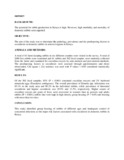Prevalence, pathology and risk factors for coccidiosis in domestic rabbits (Oryctolagus cuniculus) in selected regions in Kenya.

View/
Date
2014Author
Okumu, PO
Gathumbi, PK
Karanja, DN
Mande, JD
Wanyoike, MM
Gachuiri, CK
Kiarie, N
Mwanza, RN
Borter, DK
Language
enMetadata
Show full item recordAbstract
BACKGROUND:
The potential for rabbit production in Kenya is high. However, high morbidity and mortality of domestic rabbits were reported.
OBJECTIVE:
The aim of the study was to determine the pathology, prevalence and the predisposing factors to coccidiosis in domestic rabbits in selected regions in Kenya.
ANIMALS AND METHODS:
A total of 61 farms keeping rabbits in six different counties were visited in the survey. A total of 2680 live rabbits were examined and 61 rabbits and 302 fecal samples were randomly collected from the farms and examined for coccidian oocysts by ante-mortem and post-mortem methods. The predisposing factors to coccidiosis were assessed through questionnaires and direct observation. Chi square (χ(2)) statistics was used with P values < 0.05 considered statistically significant.
RESULTS:
Of the 302 fecal samples, 85% (P < 0.001) contained coccidian oocysts and 2% harbored nematode eggs (Passalurus ambiguous). The overall prevalence of Eimeria spp. infestation was 85.1% in the study area and 90.2% in the individual rabbits, while prevalence of intestinal coccidiosis and hepatic coccidiosis was 29.5% and 11.5%, respectively. Higher counts of coccidian oocysts per gram of feces were recovered in weaners than in growers and adults rabbits (P < 0.001), rabbits that were kept in high density group housing (P < 0.05) and housing with more than two tiers.
CONCLUSION:
This study identified group housing of rabbits of different ages and inadequate control of concurrent infections as the major risk factors associated with coccidiosis in domestic rabbits in Kenya.
Citation
Vet Q. 2014 Dec;34(4)Publisher
University of Nairobi
